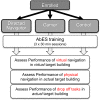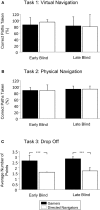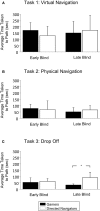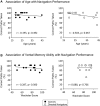Virtual environments for the transfer of navigation skills in the blind: a comparison of directed instruction vs. video game based learning approaches
- PMID: 24822044
- PMCID: PMC4013463
- DOI: 10.3389/fnhum.2014.00223
Virtual environments for the transfer of navigation skills in the blind: a comparison of directed instruction vs. video game based learning approaches
Abstract
For profoundly blind individuals, navigating in an unfamiliar building can represent a significant challenge. We investigated the use of an audio-based, virtual environment called Audio-based Environment Simulator (AbES) that can be explored for the purposes of learning the layout of an unfamiliar, complex indoor environment. Furthermore, we compared two modes of interaction with AbES. In one group, blind participants implicitly learned the layout of a target environment while playing an exploratory, goal-directed video game. By comparison, a second group was explicitly taught the same layout following a standard route and instructions provided by a sighted facilitator. As a control, a third group interacted with AbES while playing an exploratory, goal-directed video game however, the explored environment did not correspond to the target layout. Following interaction with AbES, a series of route navigation tasks were carried out in the virtual and physical building represented in the training environment to assess the transfer of acquired spatial information. We found that participants from both modes of interaction were able to transfer the spatial knowledge gained as indexed by their successful route navigation performance. This transfer was not apparent in the control participants. Most notably, the game-based learning strategy was also associated with enhanced performance when participants were required to find alternate routes and short cuts within the target building suggesting that a ludic-based training approach may provide for a more flexible mental representation of the environment. Furthermore, outcome comparisons between early and late blind individuals suggested that greater prior visual experience did not have a significant effect on overall navigation performance following training. Finally, performance did not appear to be associated with other factors of interest such as age, gender, and verbal memory recall. We conclude that the highly interactive and immersive exploration of the virtual environment greatly engages a blind user to develop skills akin to positive near transfer of learning. Learning through a game play strategy appears to confer certain behavioral advantages with respect to how spatial information is acquired and ultimately manipulated for navigation.
Keywords: early blind; games for learning; late blind; navigation; near transfer of learning; spatial cognition; videogames; virtual environment.
Figures





References
-
- Afonso A., Blum A., Katz B. F., Tarroux P., Borst G., Denis M. (2010). Structural properties of spatial representations in blind people: Scanning images constructed from haptic exploration or from locomotion in a 3-D audio virtual environment. Mem. Cogn. 38, 591–604 10.3758/MC.38.5.591 - DOI - PubMed
Grants and funding
LinkOut - more resources
Full Text Sources
Other Literature Sources
Research Materials

